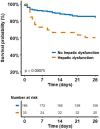Relationship between liver dysfunction, lipoprotein concentration and mortality during sepsis
- PMID: 35994439
- PMCID: PMC9394828
- DOI: 10.1371/journal.pone.0272352
Relationship between liver dysfunction, lipoprotein concentration and mortality during sepsis
Abstract
Background: High-density lipoproteins (HDLs) are synthesized by the liver and display endothelioprotective properties, including anti-inflammatory, antiapoptotic, antithrombotic and antioxidant effects. In both septic and chronic liver failure patients, a low HDL cholesterol (HDL-C) concentration is associated with overmortality. Whereas sepsis-associated liver dysfunction is poorly defined, the aim of this study was to characterize the relationship between liver dysfunction, lipoprotein concentrations and mortality in septic patients in the intensive care unit (ICU).
Methods: A prospective observational study was conducted in a university hospital ICU. All consecutive patients admitted for septic shock or sepsis were included. Total cholesterol, HDL-C, low-density lipoprotein-cholesterol (LDL-C), and triglyceride levels were assessed at admission. Sepsis-associated liver dysfunction was defined as a serum bilirubin≥ 2N or aspartate aminotransferase/alanine aminotransferase concentrations ≥ 2N. Short-term and one-year prognostic outcomes were prospectively assessed.
Results: A total of 219 septic patients were included, and 15% of them presented with sepsis-associated liver dysfunction at admission. Low concentrations of lipoproteins were associated with mortality at Day 28 in the overall population. Sepsis-associated liver dysfunction at admission was associated with overmortality. In this subgroup, patients had a lower HDL-C concentration than patients without hepatic dysfunction (HDL-C = 0.31 [0.25, 0.55] mmol/L vs. 0.48 [0.29, 0.73] mmol/L, p = 0.0079) but there was no relationship with the outcome. Interestingly, no correlation was observed between lipoprotein concentrations and liver dysfunction markers.
Conclusion: Sepsis-associated liver dysfunction at ICU admission is strongly associated with overmortality and is associated with a lower HDL-C concentration. However, in this subgroup of patients, HDL-C concentration had no relationship with mortality. Further exploratory studies are needed to better understand the interaction between lipoproteins and liver dysfunction during sepsis.
Conflict of interest statement
The authors have declared that no competing interests exist.
Figures





References
Publication types
MeSH terms
Substances
LinkOut - more resources
Full Text Sources
Medical

